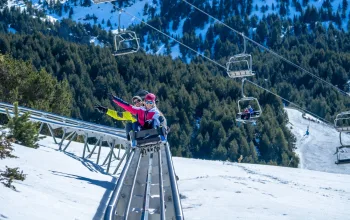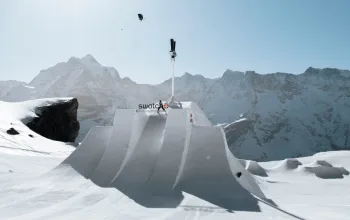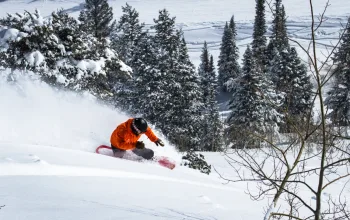Q: Can sighted skiers actually improve their technique by practicing using a blindfold?
A: Yes, absolutely! Able-bodied racers actually train with blindfolds on. It helps your proprioception – knowing where your body is in space. You learn to hear and feel things in your body that you would ordinarily overlook - because what you can see takes up so much of your focus. Taking away vision is a same kind of exercise as when you ski without poles, or on one ski. It is another tool to help you improve – to help you listen to your body.
Q: What are the advantages of not relying on vision?
A: Sighted skiers at a high level can make good adaptations before they come to something icy or steep but recreational skiers tend to panic.
It might seem counter-intuitive, bu, not relying on sight is good for me because I don’t anticipate – I can only react. When we are on ice, I’m adapting to it though my feet and through feeling, rather than looking ahead feeling anxious.
Q: You’ve had your fair share of scrapes and accidents. What causes the danger?
A: Clearly, there’s a danger because of the speed involved - and then there is the disability on top of that. When we come back from a big fall we assess what went wrong and what could we do differently. Was it a communication issue? Was it just bad luck? Mostly there is not much to change – you just have to try to minimize any risk factors and just keep going. Safety is always paramount, but there are girls out there that are just incredible skiers, particularly the Slovakians and the Russians. So if I don’t ski on the edge of my control they are going to beat me. And I don’t like coming second or third.
Q: So how do you stay safe while pushing your limits?
A: For a while I was holding back; I was skiing comfortably but I wasn’t going to win doing that. So you have figure how to overcome any fears of falling. And actually, the more you put into the ski the more you control it. If I don’t’ put in enough energy, and the ski springs out below me, that’s because I haven’t come over the top of it with my core and then driven it properly into another turn. It’s like an unruly horse - you have to let it know who is boss. Additionally, communication plays a big role in safety. Charlotte is very aware that if I’m not in the right frame of mind, we shouldn’t be skiing; and the same goes for her.
Q: What was the motivation behind you taking up skiing?
A: Skiing was the first thing that really made me feel full exhilaration. I had tried horse riding, sailing, cycling, running – but I still felt dependent, not free. There’s a lot of frustration that goes with visual impairment. I can my goggles down on a table, and walk away and come back to find them, and someone has just absentmindedly moved them. These little frustrations can build up and get you down.
But when you clip on skies and feel the wind on your face, with the mountain to explore, it’s incredible. When I first was learning, I said to myself: “If I can just get out of this snow plough and go parallel, I’ll feel free.” And when you start racing, and feel the ski bend underneath you as you go around the gates, with good technique, and get to the bottom with so much adrenalin you feel sick, it is such a buzz.
Q: Which ski resorts are your favourites to train in?
A: Mainly those in Austria in the Tirol and Salzburgland regions. We go to wherever has the best snow and training pistes, so it changes throughout the season.
Q: Can what you do inspire others?
A: I hope it can. I’d like to think we’ve really taken visually-impaired skiing forward in the past five years, showing people what’s possible - and the new kids coming through will probably out-do us. Maybe we can really narrow the gap between disabled skiing and able-bodied skiing. People hear the word disabled and think it is not as good or perceive it as a different sport, but actually when people watch the Games they see we are more advanced than most able bodied skiers. How many people can come down a Super G and be clocked at 110km per hour?
People at home who have family and friends with disabilities and are used to hearing things mentioned in a negative context. We’ll we’re showing it in a positive one. It isn’t that every visually impaired person can put on a pair of skis and do what I’m doing. Maybe instead it’s a musical instrument, singing, dance, another sport – anything. But simply to be able to do something well and let go and forget the frustration of your impairment – that’s an amazing thing to feel.

















